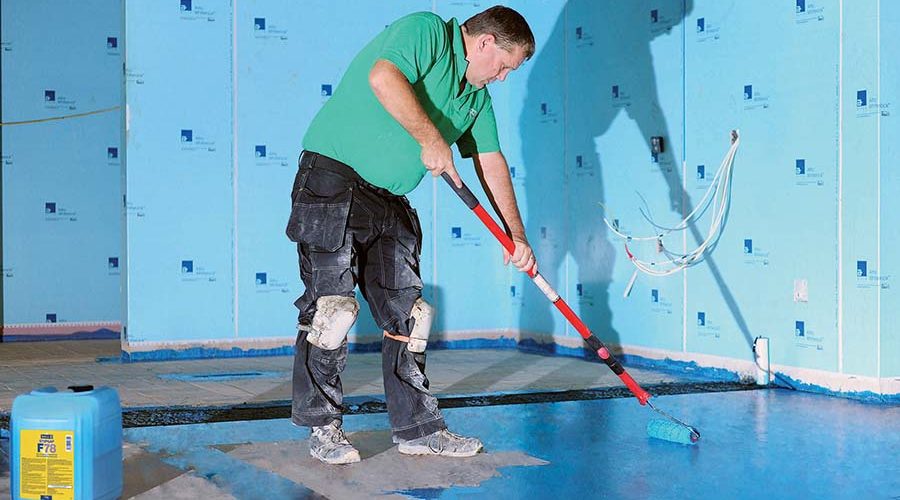Unmanaged excess subfloor moisture is the leading cause of floor failure and frequently results in delays to projects, major inconvenience and expense when remedial work is required. To help avoid these situations, Stephen Boulton, Technical Service Manager at leading subfloor preparation products manufacturer, F. Ball and Co., provides crucial advice to guard against the problems caused by excess subfloor moisture when installing floorcoverings.
F. Ball and Co. Ltd
Unchecked subfloor moisture, whether residual construction moisture or rising damp, can attack flooring adhesives and damage floorcoverings. It can also promote mould and bacterial growth. Not only can this ruin the finished appearance of a flooring installation, but it can potentially cause complete floor failure and present a health hazard. The breakdown of adhesives as a result of contact with moisture can also cause increased VOC emissions in indoor environments.
To prevent this, it is important to take time to determine subfloor moisture levels and deploy an appropriate moisture management solution, where necessary, prior to installing floorcoverings.
Testing
F. Ball recommends that a moisture test is undertaken as part of any flooring installation, having first prepared the subfloor so that it is suitably smooth, sound and free of contaminants. If the subfloor Relative Humidity (RH) levels exceed 75% (65% if wood floorcoverings are to be installed), a moisture management solution will be required to prevent excess subfloor moisture attacking adhesives and damaging floorcoverings.
A quick, non-intrusive way to identify the presence of subfloor moisture is to use a handheld radio frequency moisture meter. If the device indicates the presence of moisture in the subfloor, further testing will be required to determine the precise subfloor relative humidity levels and if a moisture management solution is required.
The only method of measuring subfloor relative humidity levels with certainty, and the method advocated by British Standards, is to use a calibrated hygrometer. These devices measure the relative humidity of a small volume of confined air in equilibrium with the subfloor, taking into account the ambient temperature.
The device is affixed to the subfloor using butyl tape to create an airtight seal around the base of the instrument. It is then left for a sufficient amount of time to allow entrapped air to reach moisture equilibrium with the screed or base before the unit is switched on. Equilibrium can generally be assumed after leaving the instrument overnight and readings taken four hours apart show identical readings. It is recommended that multiple digital hygrometers are placed at regular intervals across the entire subfloor area to make allowance for variations in moisture levels.
Waterproof surface membranes
The application of a waterproof surface membrane is the usual solution for effectively controlling damp. The best-performing epoxy waterproof surface membranes will isolate excess subfloor moisture where relative humidity values are up to 98%, with a single-coat application, which will fully cure in as little as three hours.
Quicker, two-coat systems are also available that will create an effective barrier against residual construction moisture where relative humidity values are up to 95%. The first coat cures in 15 to 20 minutes. A further 30 minutes curing time is required for the second coat.
An alternative solution
An alternative solution for dealing with damp is available for where a waterproof surface membrane cannot be applied. This may be the case where flooring installations are part of a refurbishment project and screeds are contaminated with oil, other chemicals or old adhesive residues. It is also useful in heritage settings where the subfloor must be preserved.
In these situations, a loose-lay isolator membrane can be laid directly onto the subfloor, without the requirement for an adhesive, to provide a barrier to stop excess subfloor moisture causing floor failure.
These membranes typically have nodules on the underside, creating an airspace to allow water vapour to travel to the edge of a room, into a dry wall or ventilated area, where it can safely escape. A wide range of floorcoverings can be adhered to its upper surface. This enables durable new floors to be installed and easily removed at a later date, allowing buildings to be returned to their original state and offering a solution for temporary flooring installations.
Next steps
Once a suitable moisture management solution is in place, contractors can proceed with preparing the subfloor for the installation of new floorcoverings. Where an isolator membrane has not been used, this should include the application of a levelling compound to create a perfectly smooth base for the receipt of floorcoverings, remembering to prime beforehand.
Once the levelling compound has cured, floorcoverings can be installed using an appropriate adhesive. At this stage, the compatibility of particular floorcoverings and adhesives should be checked to further ensure against floor failure. To do this, the adhesive manufacturer’s Recommended Adhesives Guide should be consulted or referring to floorcovering manufacturers’ instructions will advise the product for the optimum results.









